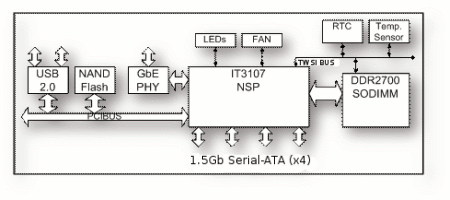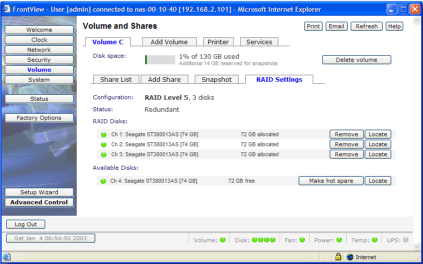Linux brings enterprise RAID features to SOHO/SMB NAS gadgets
Jul 18, 2005 — by Henry Kingman — from the LinuxDevices Archive — views Infrant Technologies is shipping an updated embedded Linux operating system for its network-attached storage (NAS) appliances, boards, and chips. RAIDiator OS 2.0 adds streaming media features, a backup manager, USB storage device support, secure remote ftp and smtp, and automatic firmware download and update.
Infrant Technologies is shipping an updated embedded Linux operating system for its network-attached storage (NAS) appliances, boards, and chips. RAIDiator OS 2.0 adds streaming media features, a backup manager, USB storage device support, secure remote ftp and smtp, and automatic firmware download and update.
Infrant is a Linux-oriented startup founded in 2001 by serial entrepreneur Paul Tien, who previously founded PCI audio specialist Platform Technologies. The company was founded with the vision of bringing enterprise-class storage technologies to the SOHO (small-office, home-office) and SMB (small-medium business) markets.
Infrant's NAS products begin with its NSPs (network storage processors), which integrate SPARC-based cores with RAID and other storage-oriented hardware engines and interfaces. The company also offers application boards for its NSPs, as well as complete off-the-shelf NAS appliances in several form-factors. All its products run RAIDiator OS, a compact yet featureful Linux implementation embedded on a 512MB CompactFlash card. RAIDiator is currently based on a 2.4-series kernel, with a 2.6 version in the works.
High-integration NSPs
Infrant is currently sampling an NSP (network storage processor) based on a 32-bit SPARC RISC core clocked at 280MHz. The NSP includes two models — the IT3102 supports two SATA channels and RAID 0/1, while the IT3107 supports four SATA channels and RAID 0/1/5.

IT3107 NSP system architecture
The IT3107 additionally supports X-RAID, a proprietary technology for RAID volume expansion that Infrant expects to ship later this summer. Infrant's marketing spokesperson, Sam Feng explains, “Currently, when you buy a RAID device, you pretty much have to buy all the disks at the same time. X-RAID will allow you to buy one disk now, then add other disks as needed down the road.”
Feng adds that X-RAID includes patent-pending volume expansion technology that requires only 20 to 30 minutes to reconfigure RAID arrays after the addition of physical drives. A background RAID synchronization process then takes over, allowing storage upgrades with very little downtime, Feng says.
Additional NSP features include Gigabit Ethernet supporting jumbo packets, a 64-bit DDR-SDRAM interface, PCI host controller, DataJunction DMA, NAND Flash interface for diskless boot, a TWSI interface (a two-wire I2C-compatible serial communication interface), and JTAG boundary scan. The chips are packaged in 449-pin lead-free PBGAs, and are currently sampling.
Application boards
Infrant currently offers two application boards, including a “Sundance” development board for its new IT3107 NSP, as well as the older IT71004 board that supports its first-generation NSPs and ships in its currently available storage appliances.
Both Infrant application boards are built in the 9.6 x 9.6 inch flex-ATX form-factor. The newer Sundance board uses SODIMM memory, however, and Infrant plans to produce smaller boards and appliances in the future — the IT310x chips have a smaller footprint than Infrant's first-generation NSPs, Feng notes.
 The Sundance application board supports the larger of its two NSPs, the IT3107. It includes a NAND boot Flash, DDR-SODIMM memory slot, USB 2.0 controller supporting four ports, one PCI slot, and four SATA connectors. A hardware monitoring circuit keeps tabs on fan speeds and chip temperatures.
The Sundance application board supports the larger of its two NSPs, the IT3107. It includes a NAND boot Flash, DDR-SODIMM memory slot, USB 2.0 controller supporting four ports, one PCI slot, and four SATA connectors. A hardware monitoring circuit keeps tabs on fan speeds and chip temperatures.
 The ReadyNAS IT71004 is a COTS (commercial off-the-shelf) system board targeting system integrators building NAS (network attached storage) devices. It is based on Infrant's IT1004 NSP, and supports four SATA disk channels, RAID 0, 1, and 5, and Gigabit Ethernet. Additional features include two USB 2.0 ports, one 184-pin 75-bit PC2700 DDR DIMM slot, RTC (real-time clock), two fan connectors with tachometer support, one onboard temperature sensor, one temperature probe connector, one CompactFlash slot, one 32-bit PCI (3.3V) slot, and HDD activity/fault LED header connector for four disks.
The ReadyNAS IT71004 is a COTS (commercial off-the-shelf) system board targeting system integrators building NAS (network attached storage) devices. It is based on Infrant's IT1004 NSP, and supports four SATA disk channels, RAID 0, 1, and 5, and Gigabit Ethernet. Additional features include two USB 2.0 ports, one 184-pin 75-bit PC2700 DDR DIMM slot, RTC (real-time clock), two fan connectors with tachometer support, one onboard temperature sensor, one temperature probe connector, one CompactFlash slot, one 32-bit PCI (3.3V) slot, and HDD activity/fault LED header connector for four disks.
NAS appliances
 Infrant claims its ReadyNAS 600 is the world's smallest RAID 5 box. Targeting the SOHO (small office / home office) and SMB (small to medium business) markets, the ReadyNAS is based on the IT71004 board described above. It supports four SATA disks, for well over a terabyte of storage. Additional features include a built-in print server, wireless-ready PCI and USB ports, UPS (uninterruptible power supply) monitoring, and a compact pedestal case measuring 8 x 8.5 x 10.5 inches (20 x 22 x 27cm) and weighing 9 pounds (4 kg) without hard drives.
Infrant claims its ReadyNAS 600 is the world's smallest RAID 5 box. Targeting the SOHO (small office / home office) and SMB (small to medium business) markets, the ReadyNAS is based on the IT71004 board described above. It supports four SATA disks, for well over a terabyte of storage. Additional features include a built-in print server, wireless-ready PCI and USB ports, UPS (uninterruptible power supply) monitoring, and a compact pedestal case measuring 8 x 8.5 x 10.5 inches (20 x 22 x 27cm) and weighing 9 pounds (4 kg) without hard drives.
 The ReadyNAS 1000 is functionally identical to the ReadyNAS 600, but packaged in a 1U rackmount case. An update under development will be available in a short 1U case. “Our storage system boards are so small, that there's a lot of wasted space in a standard 1U case,” Feng said.
The ReadyNAS 1000 is functionally identical to the ReadyNAS 600, but packaged in a 1U rackmount case. An update under development will be available in a short 1U case. “Our storage system boards are so small, that there's a lot of wasted space in a standard 1U case,” Feng said.
RAIDiator 2.0 OS
 RAIDiator 2.0 is an embedded Linux implementation optimized for Infrant's NSPs, boards, and appliances. It is packaged on a 512MB CompactFlash card.
RAIDiator 2.0 is an embedded Linux implementation optimized for Infrant's NSPs, boards, and appliances. It is packaged on a 512MB CompactFlash card.
RAIDiator aims to wrap complex configuration and management options into an easy-to-use web-based “FrontView” interface. The interface is based on HTML and Javascript, Feng says, and is tested for usability on Internet Exporer and Firefox browsers.

FrontView supports IE and Firefox
Standard features in RAIDiator include:
- Setup wizard
- RAID 0,1, or 5
- Support for hot spares
- Background RAID sync
- Enterprise-level RAID features:
- Sync resume resumes RAID synchronization where it left off, after voluntary or involuntary service interruptions (including power outages)
- Life-support mode allows recovery from accidental removal of second drive
- Scheduled snapshots
- Disk quotas
- Three security modes
- Home and small office
- Medium-sized office and workgroup
- Department or corporate environment
- Supports any operating system that has a web browser or an ftp client
- Integrated print server (USB only)
- UPS monitoring
- Data journaling
- Automatic time synchronization
- Comes with drivers for wireless PCI/USB cards
- DHCP-ready
- Interface supports English, Japanese, Traditional and Simplified Chinese, and Korean
New features available in RAIDiator 2.0 include:
- Home Media Streaming Server for streaming personal videos, music, and pictures to network DVD players
- UPnP AV support for multimedia streaming to Digital Media Adapters
- Integrated Backup Manager supporting backups between remote CIFS, NFS, FTP, HTTP, and Rsync shares and ReadyNAS data and USB storage shares
- USB Hard disk and flash device support, with file system support for Ext2, Ext3, FAT32, and NTFS
- Recycle Bin for Windows users
- FTP port designation and user login support for secure access from outside the firewall
- SMTP port designation and login allow for enhanced compatibility with external email systems
- Automatic firmware update checking and download options
- Auto power-off on disk failure option
Paul Tien, president of Infrant, says, “By working closely with ReadyNAS users, Infrant is able to quickly respond to market and OEM partner needs. Our engineering team has developed an efficient, secure, and full featured operating system based on the Infrant high performance NSP that will enable us to become the leader in the new and emerging NAS markets.”
Feng adds, “Often times, people compare our NAS to a build-it-yourself solution, and our primary advantage is simplicity and support.”
Availability
The IT310x chips are currently sampling. Sundance and IT71004 application boards are sampling and available, respectively. The ReadyNAS 600 is currently priced at $600, without drives, while the ReadyNAS 1000 costs $1,400.
An ExtremeTech review praised the ReadyNAS 600 for its robust performance, quiet operation, and RAID 5 security features.
This article was originally published on LinuxDevices.com and has been donated to the open source community by QuinStreet Inc. Please visit LinuxToday.com for up-to-date news and articles about Linux and open source.